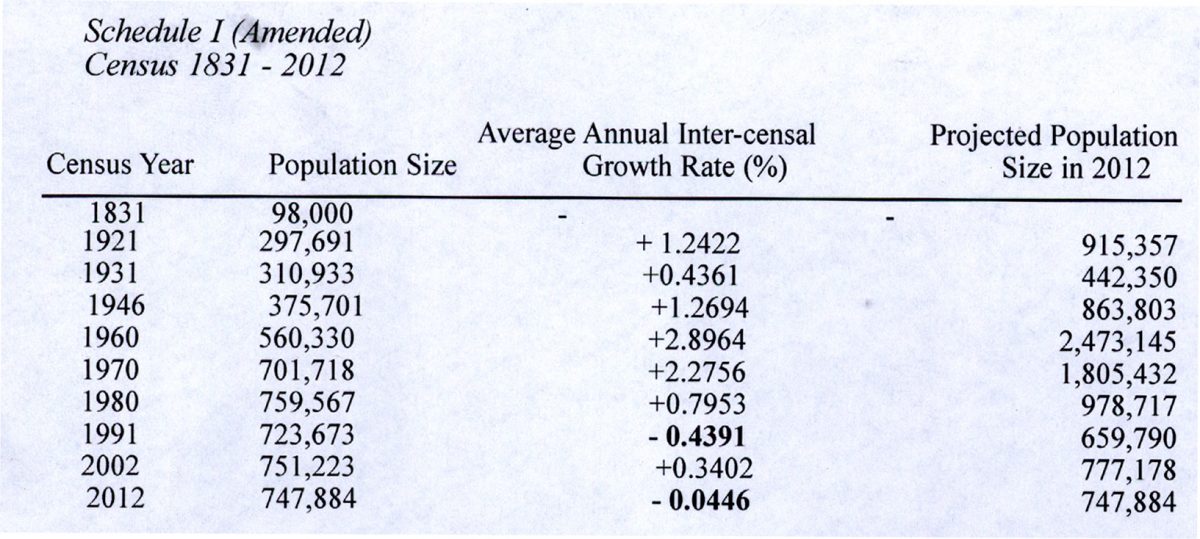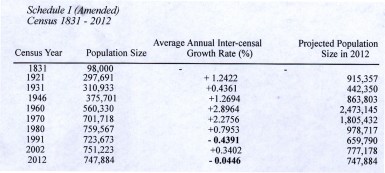Dear Editor,
Like many others, my attention was caught by Dr Clive Thomas’ article, entitled ‘Guyana’s recent population bombshell,’ which appeared in the August 3, 2014, edition of the Sunday Stabroek. I want to extend appreciation to Dr Thomas for presenting to us, in his Schedule I, the listing of our census figures for the census years from 1921 to 2012. Nonetheless, I proffer that on studying those same figures, our population issues are not recent, and the 2012 figure is no “bombshell”! Zero and negative population growth rates were features from the mid-1970s.
Indeed, if there was a ‘bombshell’ in Dr Thomas’ Schedule I, it would have been the indicated increase from 98,000 in 1921 to 310,933 in 1931. This posed so many questions that I checked it with the Bureau of Statistics – there was a transcription error; 98,000 is the figure for 1831, the census figure for 1921 is 297,691.
Allow me to reproduce below a corrected version of Dr Thomas’ Schedule I, with two additional columns:-
(i) the calculated, average annual population change during the interval of the last two censuses – the average intercensal growth rate;
(ii) the population in 2012, as projected from each census year and the preceding census figure.
Let us examine the column of average annual growth rates between census years (intercensal, to use Dr Thomas’ word). There are two periods of negative growth, all others are positive.
We may take the growth rates as a rather coarse indicator of how good people are feeling about the outlook for life in Guyana. Whether so or not, the highest intercensal growth rates were 2.8964% for the 1946 to 1960 period, and 2.2756% for the 1960 to 1970 period. Then there is the significant fall in the growth rate of about 1.5% to 0.7953% over 1970 to 1980, and a further fall of about 1.2% to – 0.4391% for the 1980-to-1991 period. There is a significant reversal of this decline in population growth, of about 0.8%, to + 0.3402% over the 1991-to-2002 period, followed by a decline of about 0.4% to – 0.0446% over the 2002-to-2012 period.
To emphasize that there is no “bombshell” in the population decline over 2002 to 2012, allow me to point out that, as far as numbers go, the intercensal decline of -0.0446% over 2002 to 2012 is just one-tenth of the -0.4391% intercensal decline of the 1980-to-1991 period!
The biggest decline in growth, “bombshell” if you wish, occurred during the 1980 to 1991 period. Dr Thomas’ analysis about the 2002 to 2012 period, would be no less cogent, and applicable to the 1980 to 1991 period. Indeed, if one projects the 1960-1970 growth rate beyond 1970, the 1980 population would have been hit already by mid-1974. I make the case that the really exceptional outward migration happened during the mid-1970s to 1991 period.
And so, I proffer this interpretation of our series of census data, after the end of immigration and the repatriation of immigrants from India. Our population was growing significantly from 1931, with a projection in 1960 of about 2.5 million in 2012. However, growth stalled in the mid-1970s, and reversed until 1991. Growth resumed over the 1991-to-2002 period, but stalled again and turned to a much smaller negative over 2002 to 2012. A correlation with what was happening politically in our country was obvious.
The question now is what will happen over 2012 to 2022, and onwards, whether the same degree of outward emigration that is indicated for the mid-1970s to 1991, will return – time will tell.
Allow me, as I close, to say that I put forward herein my interpretation of our census data, not primarily to differ with Dr Thomas (as I do, looking at the long-term trend, rather than limited to the 2002 to 2012 period, as Dr Thomas preferred), but to generate discussion, and to help incline our minds to questions of our country’s growth and development, a job that we are still to get down to, sufficiently.
I join Dr Thomas in noting “the release by the Indian Arrival Committee (IAC)” which, using the series from 1960 of per capita GDP figures for Guyana and Singapore, sounded the alarm that we have lost decades in the per capita GDP measure of growth and development.
For me, what was indicated is the need for a wide and detailed study and comparison of Guyana and Singapore, from about the end of World War II to the present.
Interestingly, BBC World recently presented a number of items on Singapore. With respect to the subject at hand – population growth and size – it was stated that Singapore, a small city- state, has now a population of about five million, with forty per cent (40%) of its citizens being immigrants born in some other country. Perhaps, we should reconcile ourselves to many of our citizens emigrating to seemingly greener pastures, reaching for the stars, sharing their hard-won earnings with and sending us remittances; and we, in turn, can throw open our doors to whomsoever sees opportunity here with us in Guyana, developing Guyana to our mutual benefit, for, indeed, we all do affirm these days that the world is one, and all humanity is one!
Yours faithfully,
Samuel A A Hinds,MP
Prime Minister






